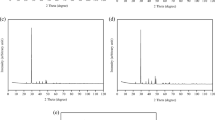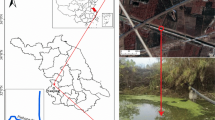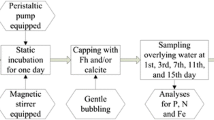Abstract
Calcite/zeolite mixture (CZ) can be used to construct a capping layer for the simultaneous management of phosphorus (P) and nitrogen (N) liberation from sediments into the overlying water (OVER-water). However, its control efficiency of sedimentary P release still needs to be improved. To address this issue, an iron-modified CZ (Fe-CZ) was synthesized, characterized, and employed as a capping material to simultaneously prevent P and N release from sediments into OVER-water. Batch and microcosm incubation experiments were performed to study the efficiency and mechanism for the control of P and N release from sediments by capping Fe-CZ. Results showed that sediment capping with Fe-CZ resulted in the significant reduction of soluble reactive P (SRP) and ammonium-N (NH3-N) in OVER-water, with reduction rates of 77.8–99.7% and 54.0–96.7%, respectively. Furthermore, the Fe-CZ capping layer decreased the SRP concentration in the pore water (PORE-water) at depth of 0–30 mm and reduced the concentration of PORE-water NH3-N at depth of 0–50 mm. Moreover, the Fe-CZ capping layer gave rise to the great decrement of the concentration of the labile P measured by DGT (diffusive gradient in thin films) technology (P-DGT) in the profile of OVER-water and sediment. Additionally, the Fe-CZ capping resulted in the reduction of redox-sensitive P (P-BD) in the 0–50 mm sediment and caused the transformation of P-BD to calcium-bound P (P-HCl) and residual P (P-RES) in the 0–10 mm sediment as well as to P-RES in the 10–20 mm sediment. Results of this work indicate that the Fe-CZ capping has a high potential for the simultaneous management of P and N release from sediments, and the decrease of the contents of sediment P-DGT, sediment P-BD, PORE-water SRP and PORE-water NH3-N as well as the conversion of mobile P to more stable P in the top sediment should have a significant role in the simultaneous interception of sedimentary P and N liberation into OVER-water by the Fe-CZ capping.









Similar content being viewed by others
References
Ajmal Z, Muhmooda A, Usman M, Kizito S, Lu JX, Dong RJ, Wu SB (2018) Phosphate removal from aqueous solution using iron oxides: adsorption, desorption and regeneration characteristics. J Colloid Interface Sci 528:145–155
Alshameri A, Ibrahim A, Assabri AM, Lei X, Wang H, Yan C (2014) The investigation into the ammonium removal performance of Yemeni natural zeolite: modification, ion exchange mechanism, and thermodynamics. Powder Technol 258:20–31
Berg U, Neumann T, Donnert D, Nüesch R, Stüben D (2004) Sediment capping in eutrophic lakes-efficiency of undisturbed calcite barriers to immobilize phosphorus. Appl Geochem 19:1759–1771
Bonaglia S, Rämö R, Marzocchi U, Le Bouille L, Leermakers M, Nascimento FJA, Gunnarsson JS (2019) Capping with activated carbon reduces nutrient fluxes, denitrification and meiofauna in contaminated sediments. Water Res 148:515–525
Burns EE, Comber S, Blake W, Goddard R, Couldrick L (2015) Determining riverine sediment storage mechanisms of biologically reactive phosphorus in situ using DGT. Environ. Sci. Pollut. R. 22:9816–9828
Chen M, Ding S, Liu L, Xu D, Han C, Zhang C (2015) Iron-coupled inactivation of phosphorus in sediments by macrozoobenthos (chironomid larvae) bioturbation: evidences from high-resolution dynamic measurements. Environ Pollut 204:241–247
Copetti D, Finsterle K, Marziali L, Stefani F, Tartari G, Douglas G, Reitzel K, Spears BM, Winfield IJ, Crosa G, D'Haese P, Yasseri S, Lürling M (2016) Eutrophication management in surface waters using lanthanum modified bentonite: a review. Water Res 97:162–174
Ding SM, Han C, Wang YP, Yao L, Wang YY, Xu D, Sun Q, Williams PN, Zhang CS (2015) In situ, high-resolution imaging of labile phosphorus in sediments of a large eutrophic lake. Water Res 74:100–109
Ding SM, Sun Q, Chen X, Liu Q, Wang D, Lin J, Zhang CS, Tsang DCW (2018) Synergistic adsorption of phosphorus by iron in lanthanum modified bentonite (Phoslock®): new insight into sediment phosphorus immobilization. Water Res 134:32–43
Dithmer L, Nielsen UG, Lürling M, Spears BM, Yasseri S, Lundberg D, Moore A, Jensen ND, Reitzel K (2016) Responses in sediment phosphorus and lanthanum concentrations and composition across 10 lakes following applications of lanthanum modified bentonite. Water Res 97:101–110
Freundlich H (1926) Colloid and capillary chemistry. Methuen, London
Fu H, Yang Y, Zhu R, Liu J, Usman M, Chen Q, He H (2018) Superior adsorption of phosphate by ferrihydrite-coated and lanthanum-decorated magnetite. J Colloid Interface Sci 530:704–713
Funes A, de Vicente J, Cruz-Pizarro L, Álvarez-Manzaneda I, de Vicente I (2016) Magnetic microparticles as a new tool for lake restoration: a microcosm experiment for evaluating the impact on phosphorus fluxes and sedimentary phosphorus pools. Water Res 89:366–374
Funes A, del Arco A, Álvarez-Manzaneda I, de Vicente J, de Vicente I (2017) A microcosm experiment to determine the consequences of magnetic microparticles application on water quality and sediment phosphorus pools. Sci Total Environ 579:245–253
Gibbs M, Özkundakci D (2011) Effects of a modified zeolite on P and N processes and fluxes across the lake sediment–water interface using core incubations. Hydrobiologia 661:21–35
Gu BW, Hong SH, Lee CG, Park SJ (2019) The feasibility of using bentonite, illite, and zeolite as capping materials to stabilize nutrients and interrupt their release from contaminated lake sediments. Chemosphere 219:217–226
Huang T, Zhou Z, Su J, Dong Y, Wang G (2013) Nitrogen reduction in a eutrophic river canal using bioactive multilayer capping (BMC) with biozeolite and sand. J Soils Sediments 13:1309–1317
Huang XJ, Shi WH, Ni JP, Li ZL (2017) Evaluation of laboratory-scale in situ capping sediments with purple parent rock to control the eutrophication. Environ Sci Pollut R 24:7114–7123
Jiang X, Jin XC, Yao Y, Li LH, Wu FC (2008) Effects of biological activity, light, temperature and oxygen on phosphorus release processes at the sediment and water interface of Taihu Lake, China. Water Res 42:2251–2259
Kang MX, Peng S, Tian YM, Zhang HY (2018) Effects of dissolved oxygen and nutrient loading on phosphorus fluxes at the sediment–water interface in the Hai River Estuary, China. Mar Pollut Bull 130:132–139
Langmuir I (1916) The constitution and fundamental properties of solids and liquids part I. Solid J Am Chem Soc 38:2221–2295
Li CJ, Yu HX, Tabassum S, Li LF, Wu DY, Zhang ZJ, Kong HN, Xu P (2017a) Effect of calcium silicate hydrates (CSH) on phosphorus immobilization and speciation in shallow lake sediment. Chem Eng J 317:844–853
Li Z, Sun X, Huang L, Liu D, Yu L, Wu H, Wei D (2017b) Phosphate adsorption and precipitation on calcite under calco-carbonic equilibrium condition. Chemosphere 183:419–428
Li CJ, Yu HX, Tabassum S, Li LF, Mu YL, Wu DY, Zhang ZJ, Kong HN, Xu P (2018) Effect of calcium silicate hydrates coupled with Myriophyllum spicatum on phosphorus release and immobilization in shallow lake sediment. Chem Eng J 331:462–470
Lin JW, Zhan YH, Zhu ZL (2011) Evaluation of sediment capping with active barrier systems (ABS) using calcite/zeolite mixtures to simultaneously manage phosphorus and ammonium release. Sci Total Environ 409:638–646
Lin L, Wan CL, Lee D-J, Lei ZF, Liu X (2014) Ammonium assists orthophosphate removal from high-strength wastewaters by natural zeolite. Sep Purif Technol 133:351–356
Lin J, Sun Q, Ding SM, Wang D, Wang Y, Chen MS, Shi L, Fan XF, Tsang DCW (2017) Mobile phosphorus stratification in sediments by aluminum immobilization. Chemosphere 186:644–651
Lin J, He S, Zhan Y, Zhang Z, Wu X, Yu Y, Zhao Y, Wang Y (2019a) Assessment of sediment capping with zirconium-modified bentonite to intercept phosphorus release from sediments. Environ. Sci. Pollut. R. 26:3501–3516
Lin JW, He SQ, Zhang HH, Zhan YH, Zhang ZB (2019b) Effect of zirconium-modified zeolite addition on phosphorus mobilization in sediments. Sci Total Environ 646:144–157
Liu Y, Sheng X, Dong YH, Ma YJ (2012) Removal of high-concentration phosphate by calcite: effect of sulfate and pH. Desalination 289:66–71
Liu C, Chen K, Wang Z, Fan C, Gu X, Huang W (2017) Nitrogen exchange across the sediment-water interface after dredging: the influence of contaminated riverine suspended particulate matter. Environ Pollut 229:879–886
Lürling M, Faassen EJ (2012) Controlling toxic cyanobacteria: effects of dredging and phosphorus-binding clay on cyanobacteria and microcystins. Water Res 46:1447–1459
Meis S, Spears BM, Maberly SC, O’Malley MB, Perkins RG (2012) Sediment amendment with Phoslock® in Clatto Reservoir (Dundee, UK): investigating changes in sediment elemental composition and phosphorus fractionation. J Environ Manag 93:185–193
Moal ML, Gascuel-Odoux C, Ménesguen A, Souchon Y, Étrillard C, Levain A, Moatar F, Pannard A, Souchu P, Lefebvre A, Pinay G (2019) Eutrophication: a new wine in an old bottle? Sci Total Environ 651:1–11
Ning D, Huang Y, Pan R, Wang F, Wang H (2014) Effect of eco-remediation using planted floating bed system on nutrients and heavy metals in urban river water and sediment: a field study in China. Sci Total Environ 485-486:596–603
Ortiz-Reyes E, Anex RP (2018) A life cycle impact assessment method for freshwater eutrophication due to the transport of phosphorus from agricultural production. J Clean Prod 177:474–482
Qin W, Gu Y, Wang G, Wu T, Zhang H, Tang X, Zhang Y, Zhao H (2018) Zirconium metal organic frameworks-based DGT technique for in situ measurement of dissolved reactive phosphorus in waters. Water Res 147:223–232
Ribeiro DC, Martins G, Nogueira R, Cruz JV, Brito AG (2008) Phosphorus fractionation in volcanic lake sediments (Azores – Portugal). Chemosphere 70:1256–1263
Rydin E, Welch EB (1998) Aluminum dose required to inactivate phosphate in lake sediments. Water Res 32:2969–2976
Smith VH, Tilman GD, Nekola JC (1999) Eutrophication: impacts of excess nutrient inputs on freshwater, marine, and terrestrial ecosystems. Environ Pollut 100:179–196
Spears BM, Meis S, Anderson A, Kellou M (2013) Comparison of phosphorus (P) removal properties of materials proposed for the control of sediment P release in UK lakes. Sci Total Environ 442:103–110
Tran HN, You SJ, Hosseini-Bandegharaei A, Chao HP (2017) Mistakes and inconsistencies regarding adsorption of contaminants from aqueous solutions: a critical review. Water Res 120:88–116
Vocciante M, De Folly D'AA, Finocchi A, Tagliabue M, Bellettato M, Ferrucci A, Reverberi AP, Ferro S (2018) Adsorption of ammonium on clinoptilolite in presence of competing cations: investigation on groundwater remediation. J Clean Prod 198:480–487
Wang CH, Pei YS (2013) Effects of light, microbial activity, and sediment resuspension on the phosphorus immobilization capability of drinking water treatment residuals in lake sediment. Environ. Sci. Pollut. R. 20:8900–8908
Wang CH, Liu JF, Pei YS (2013) Effect of hydrogen sulfide on phosphorus lability in lake sediments amended with drinking water treatment residuals. Chemosphere 91:1344–1348
Wang Y, Ding SM, Wang D, Sun Q, Lin J, Shi L, Chen MS, Zhang CS (2017) Static layer: a key to immobilization of phosphorus in sediments amended with lanthanum modified bentonite (Phoslock®). Chem Eng J 325:49–58
Wauer G, Gonsiorczyk T, Kretschmer K, Casper P, Koschel R (2005) Sediment treatment with a nitrate-storing compound to reduce phosphorus release. Water Res 39:494–500
Xiong CH, Wang DY, Tam NF, Dai YY, Zhang XM, Tang XY, Yang Y (2018) Enhancement of active thin-layer capping with natural zeolite to simultaneously inhibit nutrient and heavy metal release from sediments. Ecol Eng 119:64–72
Xu Y, F-e H, D-p L, Zhou J, Huang Y (2018) Transformation of internal sedimentary phosphorus fractions by point injection of CaO2. Chem Eng J 343:408–415
Yin H, Kong M (2015) Reduction of sediment internal P-loading from eutrophic lakes using thermally modified calcium-rich attapulgite-based thin-layer cap. J Environ Manag 151:178–185
Yin H, Han M, Tang W (2016) Phosphorus sorption and supply from eutrophic lake sediment amended with thermally-treated calcium-rich attapulgite and a safety evaluation. Chem Eng J 285:671–678
Yin H, Zhu J, Tang W (2018) Management of nitrogen and phosphorus internal loading from polluted river sediment using Phoslock® and modified zeolite with intensive tubificid oligochaetes bioturbation. Chem Eng J 353:46–55
Yoon S-Y, Lee C-G, Park J-A, Kim J-H, Kim S-B, Lee S-H, Choi J-W (2014) Kinetic, equilibrium and thermodynamic studies for phosphate adsorption to magnetic iron oxide nanoparticles. Chem Eng J 236:341–347
Young K, Morse GK, Scrimshaw MD, Kinniburgh JH, MacLeod CL, Lester JN (1999) The relation between phosphorus and eutrophication in the Thames catchment, UK. Sci Total Environ 228:157–183
Yu JH, Ding SM, Zhong JC, Fan CX, Chen QW, Yin HB, Zhang L, Zhang YL (2017) Evaluation of simulated dredging to control internal phosphorus release from sediments: focused on phosphorus transfer and resupply across the sediment-water interface. Sci Total Environ 592:662–673
Yu JH, Zhong JC, Chen QW, Huang W, Hu LM, Zhang YL, Fan CX (2018a) An investigation of the effects of capping on internal phosphorus release from sediments under rooted macrophytes (Phragmites australis) revegetation. Environ Sci Pollut R 25:24682–24694
Yu XF, Grace MR, Sun GZ, Zou YC (2018b) Application of ferrihydrite and calcite as composite sediment capping materials in a eutrophic lake. J Soils Sediments 18:1185–1193
Yu P, Wang J, Chen J, Guo J, Yang H, Chen Q (2019) Successful control of phosphorus release from sediments using oxygen nano-bubble-modified minerals. Sci Total Environ 663:654–661
Zhang H, Davison W, Gadi R, Kobayashi T (1998) In situ measurement of dissolved phosphorus in natural waters using DGT. Anal Chim Acta 370:29–38
Zhang L, Wang S, Wu Z (2014) Coupling effect of pH and dissolved oxygen in water column on nitrogen release at water–sediment interface of Erhai Lake, China. Estuar Coast Shelf S 149:178–186
Zhang W, Jin X, Liu D, Lang C, Shan B (2017) Temporal and spatial variation of nitrogen and phosphorus and eutrophication assessment for a typical arid river — Fuyang River in northern China. J Environ Sci 55:41–48
Zhang H, Elskens M, Chen G, Chou L (2019) Phosphate adsorption on hydrous ferric oxide (HFO) at different salinities and pHs. Chemosphere 225:352–359
Zhu YY, Tang WZ, Jin X, Shan BQ (2019) Using biochar capping to reduce nitrogen release from sediments in eutrophic lakes. Sci Total Environ 646:93–104
Zou YC, Grace MR, Roberts KL, Yu XF (2017) Thin ferrihydrite sediment capping sequestrates phosphorus experiencing redox conditions in a shallow temperate lacustrine wetland. Chemosphere 185:673–680
Acknowledgments
This research was financially supported by the Shandong Key Scientific and Technical Innovation Project (2018YFJH0902), the Shanghai Natural Science Foundation (15ZR1420700), the National Science Foundation of China (50908142 and 51408354), and the Scientific Research Project of Shanghai Science and Technology Committee (10230502900).
Author information
Authors and Affiliations
Corresponding author
Additional information
Responsible editor: Tito Roberto Cadaval Jr
Publisher’s note
Springer Nature remains neutral with regard to jurisdictional claims in published maps and institutional affiliations.
Rights and permissions
About this article
Cite this article
Zhan, Y., Yu, Y., Lin, J. et al. Assessment of iron-modified calcite/zeolite mixture as a capping material to control sedimentary phosphorus and nitrogen liberation. Environ Sci Pollut Res 27, 3962–3978 (2020). https://doi.org/10.1007/s11356-019-06955-5
Received:
Accepted:
Published:
Issue Date:
DOI: https://doi.org/10.1007/s11356-019-06955-5




